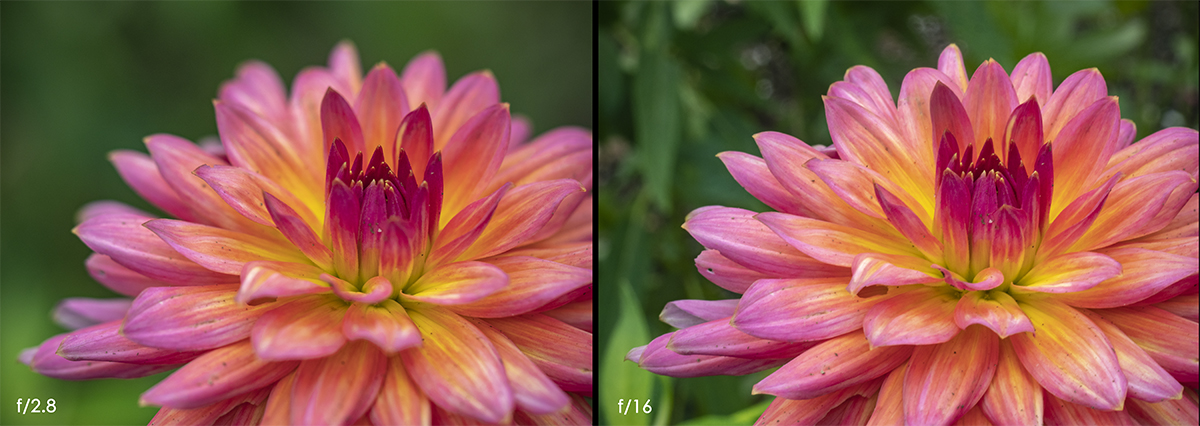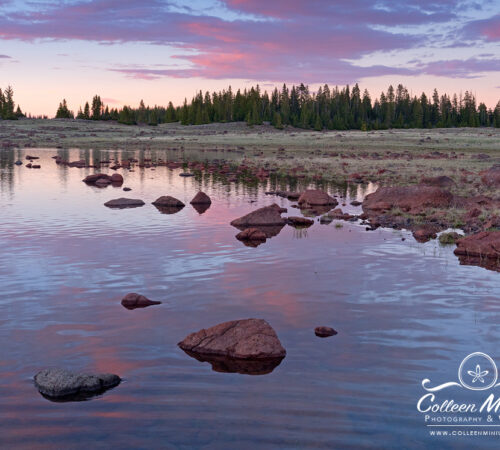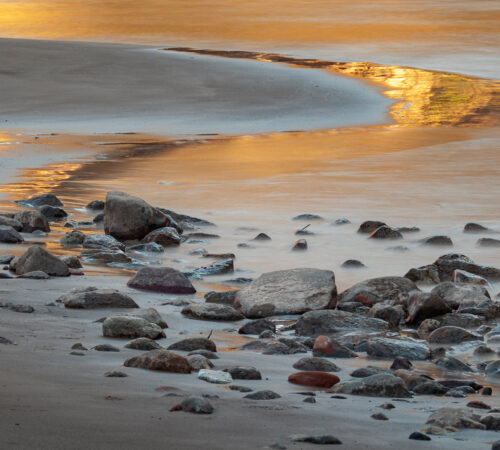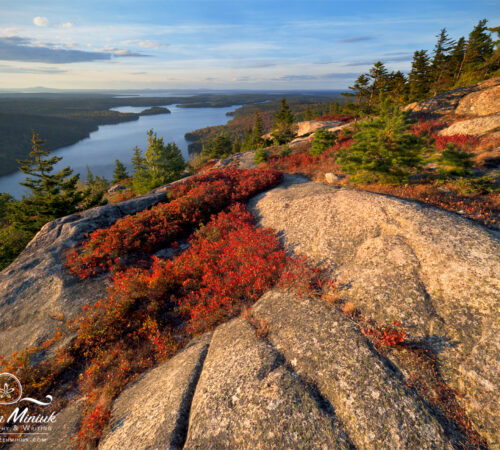Modus Operandi

Dear Bubbles:
I have a problem with learning aperture and shutter speed. I read about it, think I’ve got it, but when I go to use it I can’t remember which is which or what I’m supposed to do. So, I end up using Automatic mode rather than my Manual mode. I like taking landscape photos as well as birds and flowers so would like to be able to use Manual more often. Any help?
~Rose
Dear Rose:
Trying to learn aperture and shutter speed at the same time can often feel like you’re trying to pat your head and rub your stomach at the same time. The more you think about it, the harder it seems to get. Of course, the last thing you want to do when an elusive jaguar runs across the street under a double rainbow is stand there fumbling around with your camera trying to figure out what settings to use.
The truth is, we’ve all been there. We’ve all missed those moments, even when we know what we’re doing with aperture and shutter speed! In fast, just this past October, I missed the most fabulous photograph of a turkey strutting its tail feathers around a meadow in Cades Cove in Great Smoky Mountains National Park, TN because I was trying to switch my exposure settings in Manual mode. Oh well. I, at least, burned the memory of the experience into my personal memory card, my brain…Anyhow, I wish I could instantly take away your frustration, but take some solace in knowing that you aren’t alone in this happening, and that it’s a normal part of the learning process.
It sounds like you’ve done your homework, but for readers who might be less familiar with these exposure settings, I’m going to start with some definitions and explanations to level the playing field before I dive into ways to tackle this challenge.
Aperture refers to the circular hole in the camera lens which controls the amount of light allowed to pass on to the digital sensor (or film) during an exposure. The size of the opening is referred to as an “f-stop” (which is a calculated ratio of the lens’s focal length to the set aperture’s diameter in the lens). Even though they refer to slightly different things, we photographers tend to use the terms “aperture” and “f-stop” interchangeably. Here’s where it gets confusing:
- A wide aperture such as f/4 or f/5.6 is a bigger hole and allows the camera sensor to collect a large amount of light during the exposure.
- A small aperture such as f/16 or f/22 is a smaller hole that lets in a smaller amount of light.
But, but…sounds backwards, doesn’t it? It sure feels that way until you consider the calculated ratio, then it makes sense. Or, if your math skills are like mine (slightly above an orangutan’s), it never makes sense. Since the number of times I have asked myself during an exposure, “Hmmm, I wonder how big the hole in my lens is?” is precisely zero, I’ll offer an easier way to look at aperture. And it doesn’t involve math! (At least not on the surface…I know, I know, it’s all math…)
While aperture affects the quantity of light hitting your camera’s sensor (in conjunction with ISO and shutter speed–more on that later), the reason we care about this setting is it also controls the depth of field rendered in your image. Depth of field is how much of the image appears to be in sharp focus in your final photograph. Repeat after me, “Small number, small depth of field. Big number, big depth of field.”
- The smaller the aperture number (e.g., f/4 or f/5.6), the smaller the depth of field will appear, meaning only objects near the focal point will stay in focus while objects that are closer or further away will be increasingly out of focus.
- A bigger aperture number (e.g., f/16 or f/22) will produce a bigger depth of field, meaning objects will stay in focus across a wider range of distances.
“Small number, small depth of field. Big number, big depth of field.” This is literally the only way I ever came to understand aperture settings. It took me two years. (In my defense, I was working with film, not instantaneous digital readouts..that’s why I said slightly above an orangutan and not below…)

Shutter speed also affects the quantity of light hitting your camera’s sensor but in a different way than aperture. The shutter speed setting determines the amount of time the shutter (or one could say, the aperture hole) stays open during the exposure. It’s measured in seconds:
- A fast shutter speed lets in a small amount of light and helps to freeze any movement in your scene. Fast, freeze. The F’s.
- A slow shutter speed allows the camera to record more light and helps to blur or soften motion. Slow, soft. The S’s.
Speed here is relative. A fast shutter speed for photographers shooting ocean waves at sunrise might be 1/30th of a second which would be considered remarkably slow for photographers shooting birds in midday light.

Aperture works together with shutter speed to regulate the amount of light recorded during an exposure. (ISO is also involved, but let’s keep this simple.) There is an inverse relationship between aperture and shutter speed:
- A wide aperture (e.g. f/4 or f/5.6) lets in a lot of light so the shutter doesn’t have to be open for as long. Hence, a faster shutter speed results.
- A small aperture (e.g. f/16 or f/22) doesn’t let in a lot of light so the shutter needs to be open longer to collect an adequate amount of light. Thus, a slower shutter speed results.
Even when we recall “Small number, small depth of field. Big number, big depth of field,” and “Fast, freeze. Slow, soft,” this is A LOT of information to take in at one time and remember, especially when the jaguar and the double rainbow are out there doing their thang. Rather than try to conquer Rome in a day, let’s pick one of these settings to master at a time. Camera modes to the rescue!
Camera modes allow the photographer to define how they’d like to work with the camera to set exposure settings. When photographing in Automatic camera mode, your camera does all the thinking for you. It sets all the settings and doesn’t permit you to change them. You have the least creative control over your image-making. Manual mode is at the opposite end of the spectrum. The camera hands over the full responsibility of choosing settings to you and goes on vacation. You have the most creative control over your image making.
Going from Automatic to Manual camera mode is a big jump. It can be done, but it can come with sides of tripod kicking, strings of expletives, and occasional hair loss. If that doesn’t appeal to you, there are middle steps, less maddening ones, you can take instead.
You mentioned your interest in non-moving subjects like landscapes and flowers (“non-moving” assuming there’s no wind, that is). With these types of subjects, we’re typically more concerned with controlling depth of field, not depicting motion. Aperture is the priority, then, not shutter speed. So try photographing in Aperture-Priority (Av) mode, where you set the aperture and the camera sets the shutter speed for you. Stay in Av mode until setting the aperture becomes second nature to you. Small number, small depth of field. Big number, big depth of field. Shoot a single composition using all the different aperture settings, paying close attention to how each aperture affects the depth of field and how your camera is responding with shutter speed. Pick up a depth of field app (e.g. Dof Calc) to help you work through questions like “What aperture should I select and why?” and “Where should I focus?” This will be a slow process, so you’re going to miss a few jaguars, rainbows, and birds. It’s OK. You’ll get faster at it.
Given your interest in photographing birds, which is a moving subject, one might advise you to shoot in Shutter Speed-Priority (Tv or S) mode instead. This mode would allow you to set your desired shutter speed (to control how to depict motion), and the camera would set the appropriate aperture for you. If you’d rather expanding your learning of shutter speed first instead of aperture, use Tv/S instead. Stay in TV/S until you understand how shutter speed controls the end result. Fast, freeze. Slow, soft.
Whatever you do, though, don’t switch modes as you switch subjects! It’s too confusing. Pick either Av or Tv/S and stay there.
If you find yourself wanting to photograph birds in Av mode, just remember the inverse relationship between aperture and shutter speed. If you need a faster shutter speed to freeze motion, set a wider aperture like f/4 or f/5.6 (and a faster ISO), which will speed up the shutter speed, when you’re photographing eagles, sandhill cranes, or great blue herons. Alternatively, if you’re in Tv/S mode and want to photograph a scenic landscape, when you wish to depict extensive depth of field, set a slower shutter speed. It will let in a lot of light and dictate the use of a smaller aperture hole (which is a big number like f/16 or f/22, big depth of field). If you’re photographing a flower instead, speed up the shutter speed to render a wider aperture.
If, and only if, you eventually feel like you’re ready to move to Manual mode, you certainly can. Keep in mind, though, you can successfully create meaningful photographs with any camera mode (and with any camera). Not all remarkable photographs ever created were shot in Manual mode. You might feel so comfortable with Av or Tv/S such that you shoot with it for the rest of your days. That’s great! If you have to occasionally switch over to Automatic to make your image, that’s great, too. You do whatever you need to do to make your images, and do so proudly, without guilt or shame, girlfriend. I don’t care how you get there, how you make your images, just that you do.
Look at it this way, no one cares if you used natural gas or electricity on your stove to make a grilled cheese sandwich. Did the grilled cheese sandwich turn out? Yes? Awesome-sauce! As one of my friends likes to say, “You do you.”
Hmmmm, now that I’ve rubbed my stomach, I think I’ll go make a grilled cheese sandwich…
Be well, be wild!
~Bubbles
Have a question about photography, art, and/or the creative life? Need some advice? Send your question to Dear Bubbles at colleen@colleenminiuk.com to be possibly featured in a future column post. (If you’d prefer a different display name than your real first name, please include your preferred nickname in your note.)





2 Comments
Rose Felton
Thank you so much! This really has helped me a lot. I had shoulder surgery and can’t use my main camera right now, but as soon as I can I am going to reread your explaination and do my homework!! I am very excited to try out your ideas for my photography. Thank you again!!!
Bubbles
Hope you’re on the mend and back in photo action soon, Rose! Sending warm healing vibes to you <3